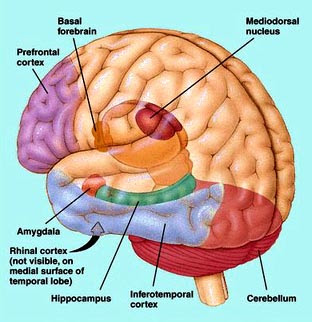CNN Reports today that:
Scientists are finding more pieces of the autism puzzle of with the help of MRI scans of brain circuitry, according to a study published Thursday online in the journal Autism Research.
By scanning the brain for 10 minutes using magnetic resonance imaging, researchers were able to measure six physical differences of microscopic fibers in the brains of 30 males with confirmed high-functioning autism and 30 males without autism.
The images of the brains helped researchers correctly identify those with autism with 94 percent accuracy, says Nicholas Lange, an associate professor of psychiatry at Harvard Medical School and one of the study authors.
"No one has measured what we measured," says Lange of the MRI test he and Dr. Janet Lainhart from the University of Utah developed.
While previous studies using different types of scans have been able to identify people with autism, Lange says, "no one has looked at it [the brain] the way we have and no one has gotten these type of results."
Lange is quick to caution that this type of test is not yet ready for prime time. "We do not want to give anyone false hopes that this is ready for the clinic yet. This method, this test, needs to be tried [and confirmed] with many more subjects outside our laboratory," he says. Plus, the research needs to be expanded to many more study participants and tried on younger people with autism and those who are not as high-functioning as the subjects in this first trial.
Using the MRI, the study authors measured how the water in the brain flows along the axons or nerve fibers in the parts of the brain that control language, social and emotional functioning. The scans revealed that the wiring of the brains of those with autism was disorganized compared with the brains of a typical person without autism. This is how they could determine which brains scans belonged those study participants with autism.
The study included only males between the ages of 7 and 28 because they were part of a bigger research project at the University of Utah, which is following males with autism for a longer period. The Centers for Disease Control and Prevention estimates 1 in 110 children in the United States have an autism spectrum disorder and boys are far more likely to have this neurological disorder that affects language and social behavior – that number is about 1 in 70. However future studies will include girls too.
Currently there's no biologic test for autism, so pediatricians look to see if a child is meeting certain developmental milestones as well as signs and symptoms of autism. (The advocacy group Autism Speaks has posted videos to help parents see the signs of autism)
The earlier a child has been identified as having autism, the earlier behavioral therapies can be applied to lessen the impact of the disorder later in life. Lange believes this brain scans can be done on younger children, as long as they can go to sleep in the scanner – on their own, without sedation (because you can't move during the test).
Carissa Cascio, an assistant professor of psychiatry from Vanderbilt University School of Medicine, who specializes in autism and neuro-imaging, believes these study results are important. But she cautions that using this method as a true diagnostic tool to detect autism in a child is "a long way off." "What this paper seems to be doing is taking the first steps towards parlaying what we are able to glean from brain imaging into potential diagnostic tools."
Zachary Warren, who is the director of the Vanderbilt Kennedy Center Treatment and Research Institute for Autism Spectrum Disorders (TRIAD), says since there are many types of autism, "it becomes very challenging to capture all these differences with one test." Still he believes this is new study can help pinpoint the earliest markers of concern in developing brains.





